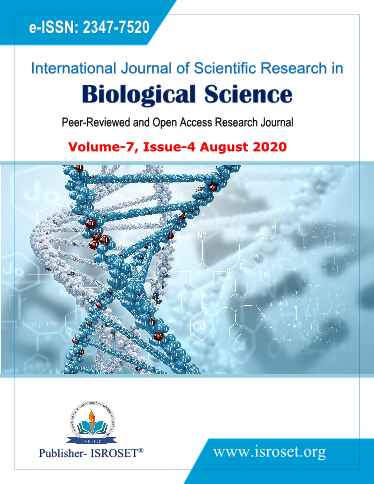Handling a Novel Nanoscale D-erythro-MAPP in Lung Cancer Treatment: An In vitro Cytotoxicity Research
Keywords:
A549, D-e-MAPP, Sphingolipid, Solid Lipid Nanoparticles, CeramidaseAbstract
Cancer disease cause high mortality rates through the world. Lung cancer has ranked between the most prevalent cancers among the rare cancer types. Surgical resection, chemotherapy and radiation are current techniques for its treatment. Besides traditional applications, it is necessary to explore and use more effective and inexpensive agents with low toxicity for lung cancer cure. While sphingolipids are the key bio-active elements of cellular membranes in high organisms, they serve as significant modulators of bio-functions of the cells as proliferation, division and death. Based on the above mentioned regulatory functions of ceramide molecule including with its role as cell signalling agent it has been regarded as a target for anticancer treatment with high potency. The utilization of nano-scale compounds for treatment approaches currently have become popular and initiate the invention of a variety of nano-materials with improved specific characteristics and multi-dimensional theranostic functions. Herein, a novel solid lipid nanoparticle of the ceramidase inhibitor, D-erythro-MAPP (D-e-MAPP), with modified targeting ability was designed, produced, and investigated as potential anticancer agent. Results imply to the high level pro-apoptotic and cytotoxic actions of the agent on lung cancer cells, thus it may be suggested for a high potent candidate for cancer therapy
References
P. Cao, B. Li, Feng Du, D. Li, Y. Wang, X. Yan, X. Li, Y. Li, ?Scutellarin Suppresses Proliferation and Promotes Apoptosis in A549 Lung Adenocarcinoma Cells via AKT/mTOR/4EBP1 and STAT3 Pathways,? Thoracic Cancer, Vol. 10, Issue.3, pp.492?500, 2019.
S.M. Cho, H.J. Kwon, ?Acid Ceramidase, an Emerging Target for Anti-Cancer and Antiangiogenesis,? Archives of Pharmacal Research, Vol. 42, pp.232?243, 2019.
N. Govindarajah, R. Clifford, D. Bowdena, P.A. Sutton, J.L. Parsons, D. Vimalachandran, ?Sphingolipids and Acid Ceramidase as Therapeutic Targets in Cancer Therapy,? Critical Reviews in Oncology / Hematology, Vol. 138, pp.104?111, 2019.
M. Raisova, G. Goltz, M. Bektas, A. Bielawska, C. Riebeling, A.M. Hossini, J. Eberle, Y.A. Hannun, C. E. Orfanos, C.C. Geilen, ?Bcl-2 Overexpression Prevents Apoptosis Induced by Ceramidase Inhibitorsin Malignant Melanoma and Hacat Keratinocytes,? FEBS Letters, Vol, 516, pp.47-52, 2002.
S. Bhatt, J. Sharma, M. Singh, V. Saini, ?Solid Lipid Nanoparticles: A Promising Technology for Delivery of Poorly Water-Soluble Drugs,? Acta Pharmaceutica Sciencia, Vol. 56, No.3, 2018.
K. Bernardo, R. Hurwitz, T. Zenk, R. J. Desnick, K. Ferlinz, E. H. Schuchman, K. Sandhoff, ?Purification, Characterization, and Biosynthesis of Human Acid Ceramidase,? Journal of Biological Chemistry, Vol. 270, pp.11098 ?11102, 1995.
M.W. Spence, S. Beed, H.W. Cook, ?Acid and Alkaline Ceramidases of Rat Tissues,? Biochemistry and Cell Biology, Vol. 64, No.5, pp.400-404, 1986.
C.W. Slife, E. Wang, R. Hunter, S. Wang, C. Burgess, D. C. Liotta, A.H. Merrill, Jr, ?Free Sphingosine Formation From Endogenous Substrates by a Liver Plasma Membrane System With a Divalent Cation Dependence and a Neutral Ph Optimum,? Journal of Biological Chemistry, Vol. 264, pp.10371?10377, 1989.
M. Sugita, M. Williams, J.T Dulaney, H.W. Moser, ?Ceramidase and Ceramide Synthesis in Human Kidney and Cerebellum: Description of a New Alkaline Ceramidase,? Biochimica et Biophysica Acta, Vol. 398, Issue.1, pp.125-131, 1975.
P.W. Wertz, D.T. Downing, ?Ceramidase Activity in Porcine Epidermis,? FEBS Letters, Vol. 268, pp.110?112, 1990.
Y.A. Hannun, ?The Sphingomyelin Cycle and The Second Messenger Function of Ceramid,? The Journal of Biological Chemistry, Vol. 269, pp.3125?3128, 1994.
A.H. Jr. Merrill, E. Wang, ?Enzymes of Ceramide Biosynthesis,? Methods Enzymol, Vol. 209, pp.427?437, 1992.
A.H., Jr. Merrill, A. Sereni, V.L. Stevens, Y.A. Hannun, R.M. Bell, J.M., Jr. Kinkade, ?Inhibition of Phorbol Ester-Dependent Differentiation of Human Promyelocytic Leukemic (HL-60) Cells by Sphinganine and Other Long-Chain Bases,? The Journal of Biological Chemistry, Vol. 261, pp.12610 ?12615, 1986.
S. Spiegel, A. Olivera, H. Zhang, E.W. Thompson, Y. Su, A. Berger, ?Sphingosine-1-phosphate, a Novel Second Messenger Involved in Cell Growth Regulation and Signal Transduction, Affects Growth and Invasiveness of Human Breast Cancer Cells.? Breast Cancer Research and Treatment, Vol. 31, pp.337?348, 1994.
B.M. Buehrer, R.M. Bell. ?Sphingosine kinase: Properties and Cellular Functions,? Advances in Lipid Research, Vol. 26, pp.59?67, 1993.
M. Pushkareva, R. Chao, A. Bielawska, A.H., Jr. Merrill, H.M. Crane, B. Lagu, D. Liotta, Y.A. Hannun, ?Stereoselectivity of Induction of The Retinoblastom Gene Product (pRb) Dephosphorylation by D-erythro-sphingosine Supports a Role for pRb in Growth Suppression by Sphingosine,? Biochemistry, Vol. 34, pp.1885?1892, 1995.
Y. Yatomi, F. Ruan, S. Hakomori, Y. Igarashi. ?Sphingosine-1-phosphate: A Platelet-Activating Sphingolipid Released From Agonist-Stimulated Human Platelets,? Blood, Vol. 86, pp.193?202, 1995.
G.S. Dbaibo, M.Y. Pushkareva, S. Jayadev, J.K. Schwarz, J.M. Horowitz, L.M. Obeid, Y.A. Hannun, ?Retinoblastoma Gene Product as a Downstream Target for a Ceramide-Dependent Pathway of Growth Arrest,? Proceedings of the National Academy of Sciences of the United States of America, Vol. 92, pp.1347?1351, 1995.
R. Chao, W. Khan, Y.A. Hannun, ?Retinoblastoma Protein Dephosphorylation Induced by D-erythro-Sphingosine,? The Journal of Biological Chemistry, Vol. 267, pp.23459 ?23462, 1992.
A. Bielawska, M.S. Greenberg, D. Perry, S. Jayadev, J. A. Shayman, C. McKay, Y.A. Hannun, ?(1S,2R)-D-erythro-2-(N-Myristoylamino)-1-phenyl-1-propanol as an Inhibitor of Ceramidase,? The Journal Of Biological Chemistry, Vol. 271, No.21, pp.12646?12654, 1996.
P. Suganya, K. Ramya, G. Suja, ?Garcinia cowa: A Potential target for Drug Therapy against Lung Cancer,? International Journal of Scientific Research in Biological Sciences, Vol.7, Issue.2, pp.180-184, 2020.
Downloads
Published
How to Cite
Issue
Section
License

This work is licensed under a Creative Commons Attribution 4.0 International License.
Authors contributing to this journal agree to publish their articles under the Creative Commons Attribution 4.0 International License, allowing third parties to share their work (copy, distribute, transmit) and to adapt it, under the condition that the authors are given credit and that in the event of reuse or distribution, the terms of this license are made clear.







